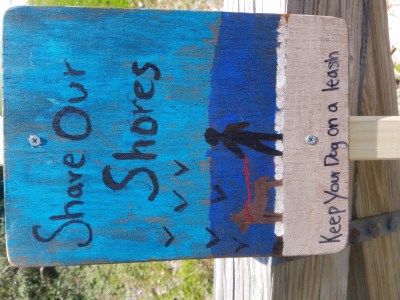Let Em’ Nest, Let Em’ Rest: Why Shorebirds Need Your Help This Season

By: Paul Laurent Kayak Guide, Naturalist, Expert Birding Guide
Summer on the Grand Strand means it’s beach time for millions of people. The sun, sand, and surf are the big draws for countless visitors each year, but the beach isn’t just popular for tourists. Shorebirds and seabirds are common sights at the beach. We see small flocks of sandpipers scurrying just beyond the breaking waves and terns plunging into the water for small fish just past the breakers. These birds don’t just look for food on the beach, they depend on the beach to raise their babies as well. The small strip of sand between the high tide line and the sand dunes is vital for them to build their nests, and unfortunately it’s the same spot most people like to put their beach towels.
Terns, sandpipers, and plovers will scrape small depressions in the sand to lay their perfectly camouflaged eggs and hatch their perfectly camouflaged babies. The nests are virtually invisible, and many people have no idea they are even there at all. Shorebird populations have decreased over 70% in the last 30 years, mainly because they are losing nesting habitat to humans. Every species of shorebird is in decline, and several are already endangered. Fortunately there are several things you can do to help the shorebirds when you visit the beach.
1.) Don’t Get Too Close
If you see a group of shorebirds sitting on the ground above the high tide line, there is a good chance they are sitting on eggs, so give them plenty of space. Getting too close can spook the adult birds, and if they fly away from their nest for too long the hot sun quickly fries the eggs and babies.
2.) Always Walk on Wet Sand
Always walk on wet sand when you’re strolling the beach. There are more shells to find, the sand is much cooler and easier to walk on, and you won’t run the risk of stepping on perfectly camouflaged nests if you are on wet sand.
3.) Leave Fido At Home
Most importantly, leave your dog at home! If you must bring your dog to the beach, keep it on a short leash and well away from the sand dunes. Dogs are the single biggest threat to shorebirds. It’s not intentional, dogs are very friendly animals, and if they are off their leash and frolicking joyfully, it only takes a few seconds for one dog to find and accidentally destroy an entire colony of nesting shorebirds. Dogs look a lot like foxes, coyotes, and raccoons, which are all natural predators for shorebirds, so a dog will spook the adult birds far sooner than a person would.
This is why places like Huntington Beach State Park don’t allow dogs past the north beach access. Most of the nesting birds at Huntington are in the northern part of the park, so keeping dogs out of that area is vital. Even if a dog is well behaved and on a leash, if the nesting birds see it even from a distance they will leave their nests, leaving eggs and babies vulnerable to the hot sun and potential predators.
By keeping these things in mind, you can have a great day at the beach and also let our native shorebirds raise their babies in peace.

The Eastern Willet is a common sight on the beaches up and down the east coast every summer. It is one of our larger sandpipers, with long legs, a long beak, and grey feathers with little black spots. When it flies, large white and black bars are visible on the wings and it often cries a loud ‘Wil-willet, wil-willet’ when it takes off. What most people don’t know is the incredible journey our Willets make every fall and spring.
The Eastern Willet nests along the east coast from Massachusetts all the way to Florida. They hide their perfectly camouflaged nests in the sand dunes, where they are virtually impossible to find. When fall comes and the babies are grown up, the Eastern Willet embarks on an incredible journey all the way to the beaches of Brazil for the winter. But the Willet doesn’t follow the coastline south, they fly straight across the ocean to Brazil, which, depending on where they leave from, is 2500 to 3500 miles! They fly this incredible distance non stop without landing to rest or eat for three to five days. In the Spring, they repeat this journey, flying straight back to their nesting sites here in the US.
We learned the details of this remarkable migration because scientists carefully caught Eastern Willets using net traps up and down the east coast during the end of summer. They put little tiny GPS trackers onto the birds with one cell solar panels to keep the battery charged. Once the Willet was fitted with its fancy little backpack, it was released. The problem was that the one cell solar panel didn’t have enough power to transmit data – the scientists had to recapture the birds the next spring to remove the GPS tracker and download the information it gathered. This seemed like it would be a big challenge. Finding the exact same birds could be impossible. It turns out it wasn’t hard at all, many of the birds were recaptured in the same trap they were caught in the year before! These incredible little birds flew from South Carolina to Brazil and back over open ocean and they landed on the same sand dune they left from!

